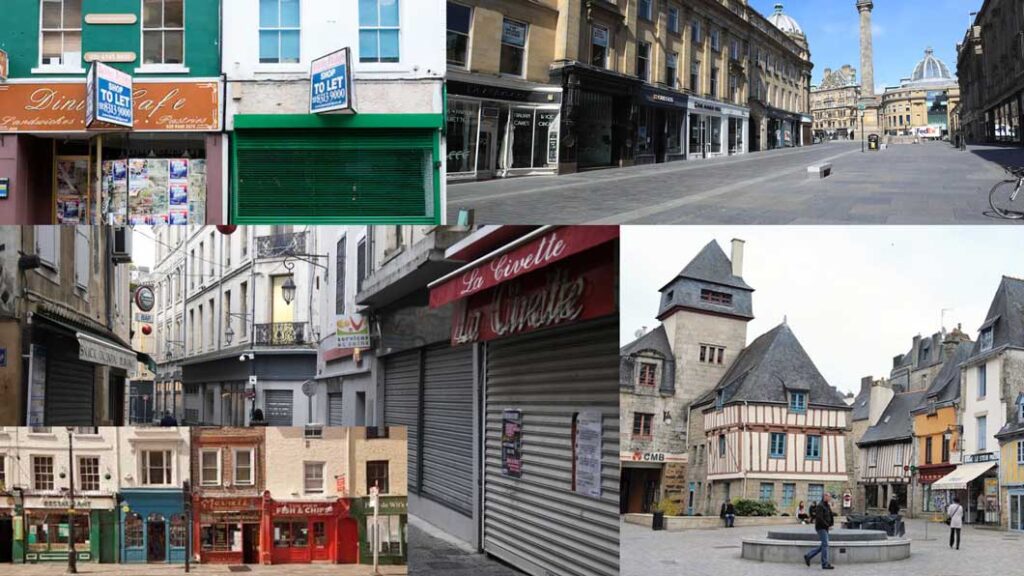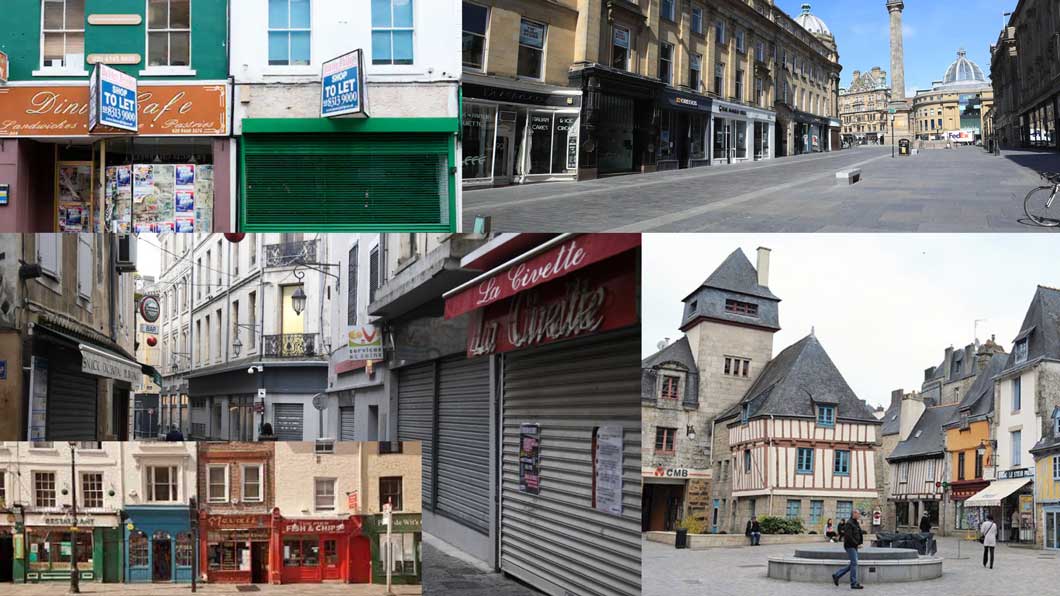“Proximity” has become a controversial term when it comes to retail. In an urban setting, “proximity” goes back to its golden age because customers find it more practical and suitable for shopping around the corner. In remote villages, proximity retail suffers. Customers find it more convenient to drive back and forth to find a retail conglomerate to make or complete their purchases.
This conflicting situation is a result of many environmental factors influencing the health of proximity retailing: the brand/the business, the commercial environment, the competitive environment, and the consumer. What incentives do retailers have to reinvest in local urban stores? What dissuades retailers from investing in local businesses in rural communities?

The dilemma of reviving small-town businesses
As the dynamics of retail also changed, so did the collective understanding of consumers about retail. A healthy retail environment requires matching investments from everyone involved. In this context, a retailer provides door-to-door delivery services, at additional prices, to customers who are prepared to pay additional fees to have their purchases delivered to their door. Clients will be more likely to shop in a more convenient way and with less hassle. For instance, a client is less likely to buy groceries 10 minutes from the bakery and 7 minutes from the butcher. A healthy retail environment is like putting a greater variety of businesses together in a convenient facility. Over the past few years, the retail sector has experienced several disparities. Urban proximity concepts are becoming more relevant, and rural proximity concepts are retreating to less relevant formats.
The revival of small-town city centres is becoming a priority as these city centres and large streets risk a “desertification” phenomenon. Torn between the need to keep “traditional” local businesses afloat and needing to inject new retail blood, many local authority initiatives have seen their ambitions fade and their beautifully written projects back on the shelf. Given this situation, startups have been invited to invest in their local communities to revive the street with local concepts. Why did not this call appeal to many?
There are several actions that small-town shop owners can take to revive their businesses. These are human-centric, technology-oriented and product-focused. Above all, shop owners must be open to change, and willing to adapt to new trends and technologies to be relevant and to stay competitive. “Togetherness” should be a guiding principle, as collaborating with other local businesses can help to create a strong local economy, increase foot traffic and visibility. Opening or reviving a retail business in remote locations should put on first:
- Embracing technology: Shop owners can use digital platforms such as e-commerce websites, social media, and online marketplaces to reach a wider customer base and compete with larger retailers.
- Creating a sense of community: Shop owners can create a sense of community by hosting events, supporting local associations, and building relationships with customers.
- Offering unique products: Shop owners can differentiate their businesses by offering unique products that cannot be found at larger retailers. This may include products that are locally sourced, handmade, or hard-to-find.
- Providing excellent customer service: Shop owners can create a loyal customer base by providing excellent customer service, such as personalized attention and a welcoming atmosphere.
- Diversifying revenue streams: Shop owners can diversify revenue streams by offering services in addition to products, such as classes, repairs, rentals or custom work.
- Making use of social media: Shop owners should regularly publish about their activity and products on social media to gain visibility, connect with customers and create potential engagement with their audiences.
Should these elements be hypothetically applied, is there the required retail infrastructure to make these projects happen?
Questionable retail infrastructure
Start-up brands often face a variety of difficulties when trying to establish themselves in the market. Some of the most common challenges include limited resources, footfall and finding the right marketing mix formula.
Start-up brands often struggle to secure funding, which can limit their ability to invest in marketing, product development, and other key areas. This also applies to cases of brands that are already established but stuck in a state of innovation neglect. The necessity of needing to reinvent themselves could be delayed due to limited resources or lack of funding. Adding up to this complex situation, start-ups (and small-town brands) may find it difficult to attract and retain top talent, as they may not have the same level of resources or reputation as larger brands.
Faced with the “retail giants syndrome”, small-town brands often struggle to attract customers, as they may not have the same level of brand recognition or marketing budget as larger brands. They may also find it difficult to establish a distribution network, as they may not have the same level of relationships or resources as larger brands. And to add complexity to the situation, these brands find it difficult to establish a reliable supply chain, as they may not have the same level of relationships or resources as larger brands.
Moreover, they find themselves stuck in regulatory and administrative situations. Having to abide by local and national regulations, start-up brand managers (small-town brand owners) find themselves in front of complex and time-consuming situations. At this point, these businesses are stuck in a level of complications before the business kicks-off or before the business sees itself through a possible opportunity of development and potential growth.
Torn between the need to develop and grow and the reality of doing so, small-town brands engage in an inevitable failure to launch.
Local authorities should contribute to enhancing local retail in small towns
At this point, there should be a shift of perspective. Local authorities are to be considered as allies and primary supporters to brands and businesses that are willing to invest in their small-towns. There should be no question to the level and type of support that is to be given, should there be the willingness to pump life back into the high street and downtown. Local authorities should review and adjust regulations that may be hindering small business growth, such as zoning and permitting laws, to make it easier for small businesses to open and operate. If they provide support through programs such as grants, low-interest loans, and business incubation centres, they would be greatly contributing to businesses’. Local authorities can also support local economic development by partnering with organizations that promote entrepreneurship, investment, and job creation in the area.
Local authorities can promote local businesses through initiatives such as “shop local” campaigns, farmer’s markets, and events that highlight the unique products and services of small-town retailers. They can also facilitate collaboration between local businesses through networking events and partnerships that bring together retailers, suppliers, and service providers. Given the current retail inclinations, retailers should encourage sustainable development by implementing policies that support energy efficiency, waste reduction, and promote sustainable transportation. Retailers should also provide training and education on topics such as digital marketing, e-commerce, and business planning. As the retail environment plays a major role in a business’s success, local authorities can make improvements to the physical environment, such as making streets more pedestrian-friendly, managing parking spaces and fees, and beautifying public spaces.

What environmental retail variables contribute to the development of proximity retail in small towns?
Several environmental retail variables are contributing to the development of proximity retail. If proximity retail is looking for ways to be closer to customers in urban areas, it is facing much struggle in rural areas. Therefore, small-town retailers are invited to focus their attention on managing the offer, the process and the people.
Small-town brands can offer localized products such as locally sourced food, artisanal products, and unique merchandise that are specific to the area they are located in. It is important to build relationships with the community by supporting local organizations, participating in community events, and engaging with customers through social media. In addition, these brands can leverage technology such as mobile payments, location-based services, and virtual reality to create a seamless and convenient shopping experience.
The overall experience is as important as creating an experiential shopping environment. The retail environment concept, theme and offer display. To give more life to these concepts, small-down brands should be offering in-store events, workshops, and personalized services to attract customers. Brands can prioritize sustainability by implementing eco-friendly practices, such as using renewable energy, reducing packaging, and using sustainable materials. Even if used minimally, brands can use data analytics and customer segmentation to personalize the shopping experience and offer products and services tailored to the specific needs of the local customers. They can also offer services such as click-and-collect or home delivery.
Still, success is a journey and is highly dependent on the willingness to adapt to new retail realities and customer changing needs…
Small-town brands can rethink their concepts to adapt them to proximity retail to revive the high street and downtown. In this environment, it is proximity retail that needs to put greater efforts in rethinking the ways they do business. They should be above all customer-centric and beyond everything, they should be extroverts. Small-town retailers need not to have the illusion of staying behind their counters and have business coming in from the front door. Brands and businesses would have to invest their efforts in making their offer come closer to customers, if not go directly to their doors.
Consumer preferences are changing; they are looking for more convenient, personalized and experiential shopping experiences. Proximity retail can provide this. Small-town retailers should be looking to integrate their online and offline presence, and proximity retail allows them to do this by providing a convenient pick-up and return location for online orders. As distance could not be a handicap in smaller towns, brands and retailers could emphasize on transportation and deliveries by foot, bicycle or other footprint-reducing means. Last-mile delivery, and proximity retail allows small-town retailers to be closer to their customers for faster and more efficient delivery.
What does the future hold for proximity retail in small villages?
The future of retail in small villages is likely to involve a combination of e-commerce and physical stores. Online retailing is likely to continue to grow in popularity, allowing small-town retailers to reach a wider customer base and compete with larger retailers. However, physical storefronts will still be important for creating a sense of community and providing a personal touch that cannot be replicated online. Retailers may also need to adapt to changing consumer preferences, such as an increased focus on sustainability and local products. The key will be to find a balance between using the benefits of online retail and maintaining the unique features of small-town shops.






